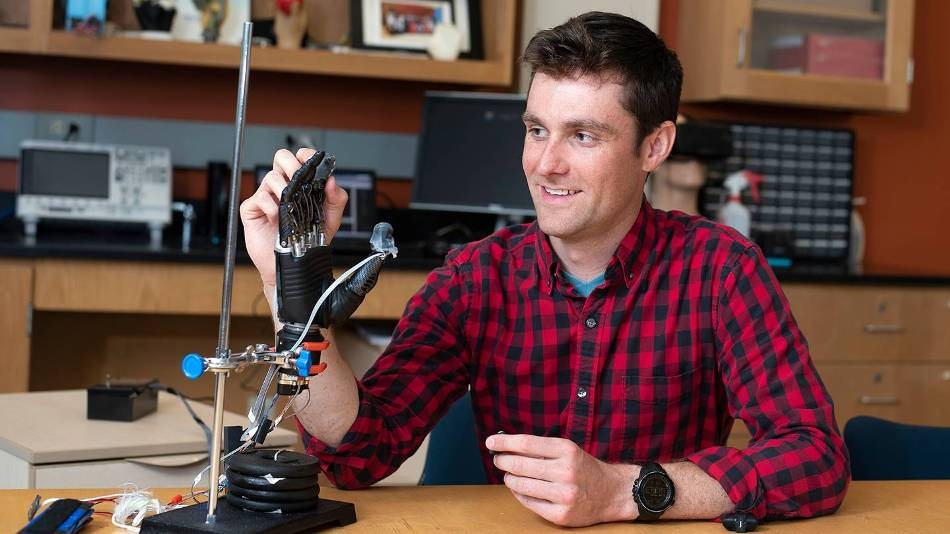Jun 21 2018
"Phantom limb" - a feeling that a missing body part is still there, is commonly experienced by amputees.
 Luke Osborn interacts with a prosthetic hand sporting the e-dermis (Image Credit: Larry Canner/Homewood Photography)
Luke Osborn interacts with a prosthetic hand sporting the e-dermis (Image Credit: Larry Canner/Homewood Photography)
A team of engineers at Johns Hopkins University are getting closer to making that sensory illusion a reality with their newly created electronic skin. When placed atop prosthetic hands, this e-dermis brings back a tangible sense via the fingertips.
"After many years, I felt my hand, as if a hollow shell got filled with life again," says the amputee who served as the team's chief volunteer. (The research protocol used in the study does not permit identification of the amputee volunteers.)
Composed of fabric and rubber connected with sensors to imitate nerve endings, the e-dermis recreates a sense of touch as well as pain by sensing stimuli and transmitting the impulses back to the peripheral nerves.
"We've made a sensor that goes over the fingertips of a prosthetic hand and acts like your own skin would," says Luke Osborn, a graduate student in biomedical engineering. "It's inspired by what is happening in human biology, with receptors for both touch and pain.
"This is interesting and new," Osborn adds, "because now we can have a prosthetic hand that is already on the market and fit it with an e-dermis that can tell the wearer whether he or she is picking up something that is round or whether it has sharp points."
The research reported online in the Science Robotics journal, reveals it is possible to restore a range of natural, touch-based feelings to amputees with prosthetic limbs. The ability to detect pain could be valuable, for example, in prosthetic hands as well as in lower limb prostheses, warning the user of possible damage to the device.
Human skin is composed of an intricate network of receptors that transmit a range of sensations to the brain. This network provided a biological model for the research team, which includes members from the Johns Hopkins departments of Biomedical Engineering, Electrical and Computer Engineering, and Neurology, and from the Singapore Institute of Neurotechnology.
Integrating a more human touch to advanced prosthetic designs is important, particularly when it comes to adding the ability to feel pain, Osborn says.
"Pain is, of course, unpleasant, but it's also an essential, protective sense of touch that is lacking in the prostheses that are currently available to amputees," he says. "Advances in prosthesis designs and control mechanisms can aid an amputee's ability to regain lost function, but they often lack meaningful, tactile feedback or perception."
That's where the e-dermis enters, transmitting information to the amputee by stimulating peripheral nerves in the arm, thus turning the so-called phantom limb into a reality. Inspired by human biology, the e-dermis enables its user to sense an unbroken spectrum of tactile perceptions, from light touch to painful or harmful stimulus.
The e-dermis achieves this by electrically triggering the nerves of the amputee in a non-invasive way, via the skin, says the senior author of the paper, Nitish Thakor, a professor of biomedical engineering and director of the Biomedical Instrumentation and Neuroengineering Laboratory at Johns Hopkins.
"For the first time, a prosthesis can provide a range of perceptions from fine touch to noxious to an amputee, making it more like a human hand," says Thakor, co-founder of Infinite Biomedical Technologies, the Baltimore-based company that supplied the prosthetic hardware used in the research.
The team developed a "neuromorphic model" imitating the touch and pain receptors of the human nervous system, enabling the e-dermis to electronically encode sensations just like the skin’s receptors would. Monitoring brain activity via electroencephalography (EEG), the team established that the test subject was able to feel these sensations in his phantom hand.
The researchers then linked the e-dermis output to the volunteer by using a noninvasive technique called transcutaneous electrical nerve stimulation (TENS). In a pain-detection task, the team established that the test subject and the prosthesis could experience a natural, reflexive reaction to both pain when touching a pointed object and non-pain when touching a round object.
The e-dermis is not sensitive to temperature - for this research, the researchers concentrated on detecting sharpness (for pain perception) and object curvature (for shape and touch perception). The e-dermis technology could be applied to create robotic systems more human, and it could also be used to extend or expand to astronaut space suits and gloves, Osborn says.
The team plans to further improve the technology and work to better comprehend how to provide meaningful sensory information to amputees in the anticipation of making the system ready for common patient use.
Johns Hopkins is an innovator in the domain of upper limb dexterous prosthesis. Over a decade ago, the university's Applied Physics Laboratory led the development of the advanced Modular Prosthetic Limb, which an amputee patient regulates with the muscles and nerves that once controlled his or her real hand or arm.
Hopkins researcher develops electronic sensory glove for prosthetics
VIDEO CREDIT: AMERICAN ACADEMY FOR THE ADVANCEMENT OF SCIENCE